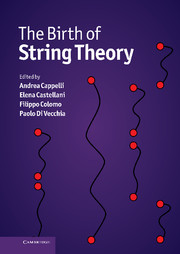Book contents
- Frontmatter
- Contents
- List of contributors
- Photographs of contributors
- Preface
- Abbreviations and acronyms
- Part I Overview
- EARLY STRING THEORY
- Part II The prehistory: the analytic S-matrix
- Part III The Dual Resonance Model
- Part IV The string
- 19 Introduction to Part IV
- 20 From dual models to relativistic strings
- 21 The first string theory: personal recollections
- 22 The string picture of the Veneziano model
- 23 From the S-matrix to string theory
- 24 The analogue model for string amplitudes
- 25 Factorization in dual models and functional integration in string theory
- 26 The hadronic origins of string theory
- TOWARDS MODERN STRING THEORY
- Part V Beyond the bosonic string
- Part VI The superstring
- Part VII Preparing the string renaissance
- Appendix A Theoretical tools of the Sixties
- Appendix B The Veneziano amplitude
- Appendix C From the string action to the Dual Resonance Model
- Appendix D World-sheet and target-space supersymmetry
- Appendix E The field theory limit
- Index
26 - The hadronic origins of string theory
from Part IV - The string
Published online by Cambridge University Press: 05 May 2012
- Frontmatter
- Contents
- List of contributors
- Photographs of contributors
- Preface
- Abbreviations and acronyms
- Part I Overview
- EARLY STRING THEORY
- Part II The prehistory: the analytic S-matrix
- Part III The Dual Resonance Model
- Part IV The string
- 19 Introduction to Part IV
- 20 From dual models to relativistic strings
- 21 The first string theory: personal recollections
- 22 The string picture of the Veneziano model
- 23 From the S-matrix to string theory
- 24 The analogue model for string amplitudes
- 25 Factorization in dual models and functional integration in string theory
- 26 The hadronic origins of string theory
- TOWARDS MODERN STRING THEORY
- Part V Beyond the bosonic string
- Part VI The superstring
- Part VII Preparing the string renaissance
- Appendix A Theoretical tools of the Sixties
- Appendix B The Veneziano amplitude
- Appendix C From the string action to the Dual Resonance Model
- Appendix D World-sheet and target-space supersymmetry
- Appendix E The field theory limit
- Index
Summary
Not by accident
The Sixties in Berkeley were exciting times for a young graduate student, not just because of the free speech movement, but also in elementary particle physics. The strong nuclear interactions appeared to be so different from the beautiful simplicity of QED that a systematic programme was underway to find a new foundation to relativistic quantum interactions. A new set of axioms was sought in the so-called S-matrix programme by abstracting properties of analyticity and unitarity exhibited in Feynman diagrams without recourse to an underlying local field theory. Remarkably this ambitious programme, guided by copious experimental data for hadronic scattering, did result in an alternative solution, now referred to as ‘string theory’. The fact that the nuclear or strong interaction was subsequently formulated by QCD, a local field theory, should not obscure this remarkable discovery. Only recently, with the advent of Maldacena's conjectured AdS/CFT correspondence between string and gauge field theory [Ma198], are we beginning to understand why two alternative solutions to strong interactions (gauge theory and its dual string theory) should co-exist as correct and equivalent theories. Whether string theory ultimately leads to a fundamental string/gauge duality for all forces including gravity, is not clear yet. Nevertheless the discovery of the theory, contrary to a widespread opinion, was not by accident, but was the result of the traditional interaction between theoretical ideas and experimental data.
Here let me give an intentionally anecdotal description of my recollections of early developments in string theory.
- Type
- Chapter
- Information
- The Birth of String Theory , pp. 312 - 326Publisher: Cambridge University PressPrint publication year: 2012
- 3
- Cited by



